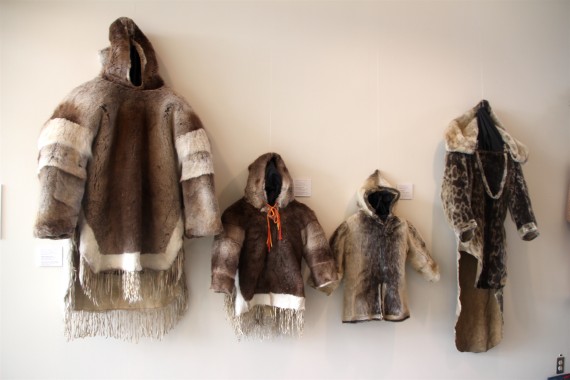Northern style: parka exhibit decks out Nunavut legislature
Nunavummiut know a thing or two about cold-weather fashion

This sunburst-style parka by Gjoa Haven’s Ruby Eleeheetook is bound to brighten up anyone’s winter. (PHOTO BY BETH BROWN)

Duffel wool used for this man’s embroidered parka and the Pangnirtung amauti was introduced into parka-making patterns when the Hudson’s Bay Company came to the North. (PHOTO BY BETH BROWN)

This family-sized set of seal- and caribou-skin parkas are typical of Baffin Inuit full fur coats, says Matty McNair, the curator of a new parka exhibit at the Nunavut legislature. (PHOTO BY BETH BROWN)

This sealskin trench coat with bear claw toggles is from a parka collection owned by the Government of Nunavut’s Fisheries and Sealing Division. (PHOTO BY BETH BROWN)
You might think the small seal- and caribou-skin parkas hung in the entrance hall of the Nunavut legislature this month belong to an earlier time—but they were actually worn by the children of Iqaluit resident Matty McNair, who curated the legislature’s new Inuit parka exhibit.
Three “North Winds Collection” parkas—named for the polar exploration company owned by McNair—are hung along with a woman’s sealskin amauti from the Nunatta Sunakkutaangit Museum. Paired with the two youth parkas and a man’s caribou parka that McNair wore in the 1990s, the four coats make for a family-style set of tradition Inuit parkas.
“That’s very typical of Baffin,” McNair said of the full seal and caribou pull-overs.
There are 16 coats, new and old, in the parka exhibit recently launched at the legislative assembly. The coats, loosely grouped by era and style, show how much diversity there is in Nunavut when it comes to cold-weather clothing.
“People love fashion up here, northern fashion,” McNair said.
The collection timeline moves from skin coverings onward, to duffel wool and cotton-based pieces that became common after the Hudson’s Bay Company set up shop in the territory.
“The Hudson’s Bay Company sold the duffel. Before the Hudson’s Bay Company was in the North, it was all sealskin and caribou,” McNair said.
The exhibit features a blue, full-length man’s wool parka with white-fur trim and detailed embroidery. The zip-up jacket is owned by Iqaluit’s Nunatta Sunakkutaangit Museum, but McNair had little information on where it came from.
A sunburst-style Mother Hubbard parka—with a face-framing fur ruff and patterned cotton cover—shows off a common style from Western Nunavut. The 2005 piece made by Ruby Elecheetok of Gjoa Haven looks similar to the coats Cambridge Bay elders were seen sporting with their running shoes, while out to vote in the territorial election this past October.
Back to the Baffin coats, McNair called a cotton-covered duffel amauti, made by Geela Maniapik in 1988, “classic Pang style,” and said that this version of the Inuit baby-carrying coat is still common today.
“I saw somebody wearing one yesterday,” she said.
The next sets of outerwear feature modern parkas, such as a floor-length sealskin trench coat with polar bear claw toggles and a man’s sealskin and duffel pea coat, both from a collection of parkas owned by the Government of Nunavut’s Fisheries and Sealing Division.
These coats are hung alongside fashion-forward pieces, like a purple Arctic Goddess jacket by designer Rannva Simonsen, an Aquatic design sealskin coat by designer Aaju Peter, and a seal-and-leather-mix Arctic Allure jacket by designer Victoria Kakutinniq.
The Victoria’s Arctic Fashion parka by Kakutinniq shows the newest trend in hot-ticket Nunavut parkas, this one having been made in 2017.
“When you see women in them, they’re very contoured, they’re lovely,” McNair said.
The parkas will remain on display until sometime in May, after which McNair is hoping to open a new exhibit of art made by youth from Cape Dorset.
She said feedback has been very positive about the beautiful exhibit of northern outerwear.
“I hope it inspires sewers in Iqaluit to use traditional designs incorporated with modern designs,” she said.
During the last sitting of the legislature, the legislative assembly foyer featured McNair’s exhibit of a variety of northern qajaqs.

A man’s sealskin dress coat from the GN’s Fisheries and Sealing coat collection couples well with this coveted VAF Arctic Allure jacket by designer Victoria Kakutinniq. (PHOTO BY BETH BROWN)

McNair said she hopes her exhibit of northern parkas inspires Iqaluit sewers to use traditional designs with their modern projects, as was done with these parkas by designers Aaju Peter, left, and Rannva Simonsen. (PHOTO BY BETH BROWN)





(0) Comments